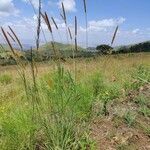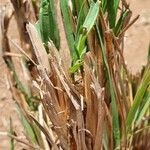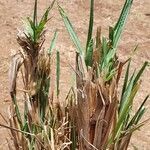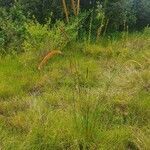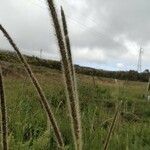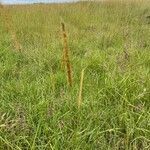Golden bristle grass, twisted leaf bristle grass, creeping bristle grass Tufted, robust to almost reed-like perennial, 0.4-2.0 m high; sometimes rhizomatous occasionally with stilt roots; nodes glabrous. Leaf blade 100-800 x 1-18 mm, flat; ligule a fringed membrane or a fringe of hairs. Inflorescence a spike-like panicle, 25-500 mm long; spikelets subtended by 6-15 bristles; bristles 4-10 mm long, slender, finely scabrid, golden-yellow to reddish brown, persistent on axis after spikelets fall. Spikelets 1.5-3.5 mm long, dorsiventrally compressed; lower glume 3-nerved; upper glume 3-5-nerved. Florets 2; lower floret male or sterile, lemma widely grooved; upper floret bisexual, lemma indurated, coarsely rugose, entire; anther 0.7-1.8 mm long. Flowering time Oct.-June.
A grass which keeps growing from year to year. It is 0.5-2 m tall. It normally forms compact tufts. Some kinds have long creeping stolons and form tillers. The stems are erect and simple. The leaves can be smooth or hairy. They are narrow and taper to a short tip. The flower is a slender spike-like head 7.5-25 cm long. It is often golden in colour.
Panicle 3–50 cm. long, spiciform, cylindrical, spikelets mostly pallid to purple with fulvous bristles, the rhachis tomentellous; bristles 1.5–12 mm. long, 6–15 below each cluster of 1–4 spikelets.
Rhizomatous perennial to 1 m. Leaves linear, mostly rolled. Spikelets 2-3 mm long, in a spike-like panicle, golden-yellow, bristles 7-15 per cluster, lower glume 3-nerved.
Spikelets 1.5–3.5 mm. long, elliptic, oblique but scarcely gibbous or laterally compressed.
Inferior glume up to 1/2, the superior 1/3–2/3(3/4) length of spikelet and (3)5-nerved.
Superior floret rugose, usually strongly so, but occasionally almost smooth.
Caespitose perennial about 1 m. high, arising from a short rhizome.
Culms 20–300 cm. high, the nodes quite glabrous.
Tufted perennial, arising from a short rhizome.
Inferior floret male, its lemma thinly papery.
